Gaseous Plastron on Natural and Biomimetic Surfaces for Resisting Marine Biofouling
Abstract
1. Introduction
2. Factors Influencing the Formation and Maintenance of Gaseous Plastron
2.1. Surface Wettability
2.2. Buoyancy
2.3. Micro/nano-Morphologies
3. Antifouling Strategy Leveraged by Natural Organisms Bearing Gaseous Plastron
3.1. Lotus Leaf
3.2. Flower Petals
3.3. Water Spider
3.4. Salvinia
4. Application of Gaseous Plastron for Anti-Fouling
5. Conclusions
Author Contributions
Funding
Institutional Review Board Statement
Informed Consent Statement
Data Availability Statement
Acknowledgments
Conflicts of Interest
Sample Availability
References
- Vinagre, P.; Simas, T.; Cruz, E.; Pinori, E.; Svenson, J. Marine biofouling: A european database for the marine renewable energy sector. J. Mar. Sci. Eng. 2020, 8, 495. [Google Scholar] [CrossRef]
- Faria, S.I.; Teixeira-Santos, R.; Gomes, L.C.; Silva, E.R.; Morais, J.; Vasconcelos, V.; Mergulhão, F.J.M. Experimental assessment of the performance of two marine coatings to curb biofilm formation of microfoulers. Coatings 2020, 10, 893. [Google Scholar] [CrossRef]
- Nalini, S.; Sandy Richard, D.; Mohammed Riyaz, S.U.; Kavitha, G.; Inbakandan, D. Antibacterial macro molecules from marine organisms. Int. J. Biol. Macromol. 2018, 115, 696–710. [Google Scholar] [CrossRef]
- Roubeix, V. Epidiatomic diatoms: An insight into interaction specificity. Phycol. Res. 2020, 68, 249–253. [Google Scholar] [CrossRef]
- Li, Q.; Sun, C.; Wang, Y.; Cai, H.; Li, L.; Li, J.; Shi, H. Fusion of microplastics into the mussel byssus. Environ. Pollut. 2019, 252, 420–426. [Google Scholar] [CrossRef] [PubMed]
- Pearson, R.M.; van de Merwe, J.P.; Connolly, R.M. Global oxygen isoscapes for barnacle shells: Application for tracing movement in oceans. Sci. Total Environ. 2020, 705, 135782. [Google Scholar] [CrossRef]
- Monty, J.P.; Dogan, E.; Hanson, R.; Scardino, A.J.; Ganapathisubramani, B.; Hutchins, N. An assessment of the ship drag penalty arising from light calcareous tubeworm fouling. Biofouling 2016, 32, 451–464. [Google Scholar] [CrossRef]
- Townsin, R. The ship hull fouling penalty. Biofouling 2003, 19, 9–15. [Google Scholar] [CrossRef] [PubMed]
- Champ, M.A. A review of organotin regulatory strategies, pending actions, related costs and benefits. Sci. Total Environ. 2000, 258, 21–71. [Google Scholar] [CrossRef]
- Yebra, D.M.; Kiil, S.; Dam-Johansen, K. Antifouling technology—past, present and future steps towards efficient and environmentally friendly antifouling coatings. Prog. Org. Coat. 2004, 50, 75–104. [Google Scholar] [CrossRef]
- Lewis, J.; Coutts, A. Biofouling invasions. Biofouling 2010, 24, 348–365. [Google Scholar]
- Vladkova, T. Surface engineering for non-toxic biofouling control. J. Univ. Chem. Technol. Metall. 2007, 42, 239–256. [Google Scholar]
- Vladkova, T. Surface modificationapproach to control biofouling. Marine Indust. Biofouling 2009, 4, 135–163. [Google Scholar]
- Vladkova, T.; Akuzov, D.; Koeppel, A.; Bruemmer, F. Current approaches to reduction marine biofilm formation. J. Chem. Technol. Metall. 2014, 49, 345–355. [Google Scholar]
- Ditsche-Kuru, P.; Schneider, E.S.; Melskotte, J.E.; Brede, M.; Leder, A.; Barthlott, W. Superhydrophobic surfaces of the water bug notonecta glauca: A model for friction reduction and air retention. Beilstein J. Nanotechnol. 2011, 2, 137–144. [Google Scholar] [CrossRef] [PubMed]
- Balmert, A.; Florian Bohn, H.; Ditsche-Kuru, P.; Barthlott, W. Dry under water: Comparative morphology and functional aspects of air-retaining insect surfaces. J. Morphol. 2011, 272, 442–451. [Google Scholar] [CrossRef]
- Cui, X.; Liu, J.; Xie, L.; Huang, J.; Liu, Q.; Israelachvili, J.N.; Zeng, H. Modulation of hydrophobic interaction by mediating surface nanoscale structure and chemistry, not monotonically by hydrophobicity. Angew Chem. Int. Ed. Engl. 2018, 57, 11903–11908. [Google Scholar] [CrossRef]
- Yousefi, S.Z.; Tabatabaei-Panah, P.S.; Seyfi, J. Emphasizing the role of surface chemistry on hydrophobicity and cell adhesion behavior of polydimethylsiloxane/TiO2 nanocomposite films. Colloid. Surface. B 2018, 167, 492–498. [Google Scholar] [CrossRef]
- Zheng, D.; Jiang, Y.; Yu, W.; Jiang, X.; Zhao, X.; Choi, C.-H.; Sun, G. Salvinia-effect-inspired “sticky” superhydrophobic surfaces by meniscus-confined electrodeposition. Langmuir 2017, 33, 13640–13648. [Google Scholar] [CrossRef]
- Scardino, A.J.; Harvey, E.; De Nys, R. Testing attachment point theory: Diatom attachment on microtextured polyimide biomimics. Biofouling 2006, 22, 55–60. [Google Scholar] [CrossRef]
- Scardino, A.J.; Guenther, J.; de Nys, R. Attachment point theory revisited: The fouling response to a microtextured matrix. Biofouling 2008, 24, 45–53. [Google Scholar] [CrossRef]
- Wu, A.H.F.; Nakanishi, K.; Cho, K.L.; Lamb, R. Diatom attachment inhibition: Limiting surface accessibility through air entrapment. Biointerphases 2013, 8, 5. [Google Scholar] [CrossRef] [PubMed]
- Branner, F.G. Means and method for protection from marine parasites. U.S. Patent No. 123,021, 29 January 1937. [Google Scholar]
- Wang, B.; Zhang, Y.; Shi, L.; Jing, L.; Guo, Z. Advances in the theory of superhydrophobic surfaces. J. Mater. Chem. 2012, 22, 20112–20127. [Google Scholar] [CrossRef]
- Bonn, D.; Eggers, J.; Indekeu, J.; Meunier, J.; Rolley, E. Wetting and spreading. Rev. Mod. Phys. 2009, 81, 739–805. [Google Scholar] [CrossRef]
- Ishida, N.; Sakamoto, M.; Miyahara, M.; Higashitani, K. Optical observation of gas bridging between hydrophobic surfaces in water. J. Colloid Interf. Sci. 2002, 253, 112–116. [Google Scholar] [CrossRef] [PubMed]
- Bhushan, B.; Jung, Y.C. Wetting, adhesion and friction of superhydrophobic and hydrophilic leaves and fabricated micro/nanopatterned surfaces. J. Phys. Condens. Matter. 2008, 20, 225010–225033. [Google Scholar] [CrossRef]
- Hu, H.S.; Watson, G.S.; Cribb, B.W.; Watson, J.A. Non-wetting wings and legs of the cranefly aided by fine structures of the cuticle. J. Exper. Biol. 2010, 214, 915–920. [Google Scholar] [CrossRef]
- Bush, J.W.M.; Hu, D.L.; Prakash, M. The integument of water-walking arthropods: Form and function. Adv. Insect Physiol. 2008, 34, 117–192. [Google Scholar]
- Du, P.; Hu, H.; Ren, F.; Song, D. Bubble characterizations on hydrophobic surface using lattice boltzmann simulation with large density ratios. Int. J. Numer. Meth. H. 2017, 27, 1311–1322. [Google Scholar] [CrossRef]
- Wang, S.; Jiang, L. Definition of superhydrophobic states. Adv. Mater. 2007, 19, 3423–3424. [Google Scholar] [CrossRef]
- Lafuma, A.; Quéré, D. Superhydrophobic states. Nat. Mater. 2003, 2, 457–460. [Google Scholar] [CrossRef] [PubMed]
- Nakajima, A.; Hashimoto, K.; Watanabe, T. Recent studies on super-hydrophobic films. Monatsh. Chem. 2001, 132, 31–41. [Google Scholar] [CrossRef]
- Patankar, N.A. On the modeling of hydrophobic contact angles on rough surfaces. Langmuir 2003, 19, 1249–1253. [Google Scholar] [CrossRef]
- Gao, L.; McCarthy, T.J. The “lotus effect” explained: Two reasons why two length scales of topography are important. Langmuir 2006, 22, 2966–2967. [Google Scholar] [CrossRef] [PubMed]
- Feng, Y.; Li, S.H.; Li, Y.; Li, H.J.; Zhang, L.; Zhai, J.; Song, Y.L.; Liu, B.Q.; Jiang, L.; Zhu, D.B. Super-hydrophobic surfaces: From natural to artificial. Adv. Mater. 2003, 14, 1857–1860. [Google Scholar] [CrossRef]
- Wang, J.; Zheng, Y.; Nie, F.Q.; Zhai, J.; Jiang, L. Air bubble bursting effect of lotus leaf. Langmuir 2009, 25, 14129–14134. [Google Scholar] [CrossRef]
- Tsori, Y. Discontinuous liquid rise in capillaries with varying cross-sections. Langmuir 2006, 22, 8860–8863. [Google Scholar] [CrossRef]
- Ling, W.Y.L.; Lu, G.; Ng, T.W. Increased stability and size of a bubble on a superhydrophobic surface. Langmuir 2011, 27, 3233–3237. [Google Scholar] [CrossRef] [PubMed]
- Cross, M.; Varhue, W.; McDevitt, R.; Hitt, D. Effect of wetting on the ability of nanomaterials to act as effective catalysts. Adv. Chem. Eng. Sci. 2016, 6, 541–552. [Google Scholar] [CrossRef]
- Herminghaus, S. Roughness-induced non-wetting. Europhys. Lett. 2000, 52, 165–170. [Google Scholar] [CrossRef]
- Marmur, A. Underwater superhydrophobicity: Theoretical feasibility. Langmuir 2006, 22, 1400–1402. [Google Scholar] [CrossRef] [PubMed]
- Barthlott, W.; Schimmel, T.; Wiersch, S.; Koch, K.; Brede, M.; Barczewski, M.; Walheim, S.; Weis, A.; Kaltenmaier, A.; Leder, A.; et al. The salvinia paradox: Superhydrophobic surfaces with hydrophilic pins for air retention under water. Adv. Mater. 2010, 22, 2325–2328. [Google Scholar] [CrossRef]
- Mail, M.; Moosmann, M.; Häger, P.; Barthlott, W. Air retaining grids-a novel technology to maintain stable air layers under water for drag reduction. Phil. Trans. R. Soc. 2019, 377, 20190126. [Google Scholar] [CrossRef] [PubMed]
- Darmanin, T.; Guittard, F. Superhydrophobic and superoleophobic properties in nature. Mater. Today 2015, 18, 273–285. [Google Scholar] [CrossRef]
- Guo, Z.; Liu, W. Biomimic from the superhydrophobic plant leaves in nature: Binary structure and unitary structure. Plant Sci. 2007, 172, 1103–1112. [Google Scholar] [CrossRef]
- Ishida, N.; Sakamoto, M.; Miyahara, M.; Higashitani, K. Attraction between hydrophobic surfaces with and without gas phase. Langmuir 2000, 16, 5681–5687. [Google Scholar] [CrossRef]
- Tyrrell, J.W.G.; Attard, P. Atomic force microscope images of nanobubbles on a hydrophobic surface and corresponding force−separation data. Langmuir 2002, 18, 160–167. [Google Scholar] [CrossRef]
- Tyrrell, J.W.; Attard, P. Images of nanobubbles on hydrophobic surfaces and their interactions. Phys. Rev. Lett. 2001, 87, 176104. [Google Scholar] [CrossRef]
- Nguyen, A.; Stechemesser, H. Influence of dewetting kinetics on bubble-particle interaction. Phys. Chem. Chem. Phys. 2004, 6, 429–433. [Google Scholar] [CrossRef]
- Carrier, V.; Colin, A. Coalescence in draining foams. Langmuir 2003, 19, 4535–4538. [Google Scholar] [CrossRef]
- Bormashenko, E.; Stein, T.; Pogreb, R.; Aurbach, D. “Petal effect” on surfaces based on lycopodium: High-stick surfaces demonstrating high apparent contact angles. J. Phys. Chem. C 2009, 113, 5568–5572. [Google Scholar] [CrossRef]
- Feng, L.; Zhang, Y.; Xi, J.; Zhu, Y.; Wang, N.; Xia, F.; Jiang, L. Petal effect: A superhydrophobic state with high adhesive force. Langmuir 2008, 24, 4114–4119. [Google Scholar] [CrossRef]
- Liu, Y.; Zhang, X. Nanobubble stability induced by contact line pinning. J. Chem. Phys. 2013, 138, 014706. [Google Scholar] [CrossRef] [PubMed]
- Dou, X.-Q.; Zhang, D.; Feng, C.; Jiang, L. Bioinspired hierarchical surface structures with tunable wettability for regulating bacteria adhesion. ACS Nano 2015, 9, 10664–10672. [Google Scholar] [CrossRef] [PubMed]
- Truong, V.K.; Webb, H.K.; Fadeeva, E.; Chichkov, B.N.; Wu, A.H.F.; Lamb, R.; Wang, J.Y.; Crawford, R.J.; Ivanova, E.P. Air-directed attachment of coccoid bacteria to the surface of superhydrophobic lotus-like titanium. Biofouling 2012, 28, 539–550. [Google Scholar] [CrossRef] [PubMed]
- Seymour, R.S.; Hetz, S.K. The diving bell and the spider: The physical gill of argyroneta aquatica. J. Exp. Biol. 2011, 214, 2175–2181. [Google Scholar] [CrossRef]
- Zheng, Y.; Bai, H.; Huang, Z.; Tian, X.; Nie, F.-Q.; Zhao, Y.; Zhai, J.; Jiang, L. Directional water collection on wetted spider silk. Nature 2010, 463, 640–643. [Google Scholar] [CrossRef] [PubMed]
- Koch, K.; Bhushan, B.; Barthlott, W. Multifunctional surface structures of plants: An inspiration for biomimetics. Pro. Mater. Sci. 2009, 54, 137–178. [Google Scholar] [CrossRef]
- Park, Y.M.; Gang, M.; Seo, Y.H.; Kim, B.H. Artificial petal surface based on hierarchical micro- and nanostructures. Thin Solid Films 2011, 520, 362–367. [Google Scholar] [CrossRef]
- Huang, C.; Guo, Z. The wettability of gas bubbles: From macro behaviors to nano structures to applications. Nanoscale 2018, 10, 19659–19672. [Google Scholar] [CrossRef]
- Mayser, M.; Bohn, H.; Reker, M.; Barthlott, W. Measuring air layer volumes retained by submerged floating-ferns salvinia and biomimetic superhydrophobic surfaces. Beilstein J. Nanotechnol. 2014, 5, 812–821. [Google Scholar] [CrossRef] [PubMed]
- Barthlott, W.; Mail, M.; Bhushan, B.; Koch, K. Plant surfaces: Structures and functions for biomimetic innovations. Nano-Micro. Lett. 2017, 9, 23. [Google Scholar] [CrossRef]
- Barthlott, W.; Mail, M.; Neinhuis, C. Superhydrophobic hierarchically structured surfaces in biology: Evolution, structural principles and biomimetic applications. Philos. Trans. R. Soc. A Sci. 2016, 374, 20160191. [Google Scholar] [CrossRef]
- Barthlott, W.; Wiersch, S.; Čolić, Z.; Koch, K. Classification of trichome types within species of the water fern salvinia, and ontogeny of the egg-beater trichomes. Botany 2009, 87, 830–836. [Google Scholar] [CrossRef]
- Barthlott, W.; Riede, K. Mimicry and ultrastructural analogy between the semi-aquatic grasshopper paulinia acuminata (orthoptera) and its foodplant, the water-fern salvinia auriculata (filicatae). Amazoniana 1994, 13, 47–58. [Google Scholar]
- Amabili, M.; Giacomello, A.; Meloni, S.; Casciola, C.M. Unraveling the salvinia paradox: Design principles for submerged superhydrophobicity. Adv. Mater. Interfaces 2015, 2, 1500248. [Google Scholar] [CrossRef]
- Babu, D.; Mail, M.; Barthlott, W.; Schneider, J. Superhydrophobic vertically aligned carbon nanotubes for biomimetic air retention under water (salvinia effect). Adv. Mater. Interfaces 2017, 4, 1700273. [Google Scholar] [CrossRef]
- Xiang, Y.; Huang, S.; Huang, T.-Y.; Dong, A.; Cao, D.; Li, H.; Xue, Y.; Lv, P.; Duan, H. Superrepellency of underwater hierarchical structures on Salvinia leaf. Proc. Natl. Acad. Sci. USA 2020, 117, 2282–2287. [Google Scholar] [CrossRef] [PubMed]
- Schumacher, J.F.; Carman, M.L.; Estes, T.G.; Feinberg, A.W.; Wilson, L.H.; Callow, M.E.; Callow, J.A.; Finlay, J.A.; Brennan, A.B. Engineered antifouling microtopographies–effect of feature size, geometry, and roughness on settlement of zoospores of the green alga ulva. Biofouling 2007, 23, 55–62. [Google Scholar] [CrossRef]
- Carman, M.L.; Estes, T.G.; Feinberg, A.W.; Schumacher, J.F.; Wilkerson, W.; Wilson, L.H.; Callow, M.E.; Callow, J.A.; Brennan, A.B. Engineered antifouling microtopographies–correlating wettability with cell attachment. Biofouling 2006, 22, 11–21. [Google Scholar] [CrossRef]
- Cai, Y.; Wang, L.; Hu, H.; Bing, W.; Tian, L.; Zhao, J. A synergistic antibacterial platform: Combining mechanical and photothermal effects based on van-mos2–au nanocomposites. Nanotechnology 2021, 32, 085102. [Google Scholar] [CrossRef] [PubMed]
- Chen, Z.; Wang, Z.; Ren, J.; Qu, X. Enzyme mimicry for combating bacteria and biofilms. Acc. Chem. Res. 2018, 51, 789–799. [Google Scholar] [CrossRef] [PubMed]
- Bers, A.V.; Wahl, M. The influence of natural surface microtopographies on fouling. Biofouling 2004, 20, 43–51. [Google Scholar] [CrossRef] [PubMed]
- Bing, W.; Tian, L.; Wang, Y.; Jin, H.; Ren, L.; Dong, S. Biofouling: Bio-inspired non-bactericidal coating used for antibiofouling. Adv. Mater. Technol. 2019, 4, 1800480. [Google Scholar] [CrossRef]
- Callow, J.A.; Callow, M.E. Trends in the development of environmentally friendly fouling-resistant marine coatings. Nat. Commun. 2011, 2, 244–254. [Google Scholar] [CrossRef]
- Banerjee, I.; Pangule, R.C.; Kane, R.S. Antifouling coatings: Recent developments in the design of surfaces that prevent fouling by proteins, bacteria, and marine organisms. Adv. Mater. 2011, 23, 690–718. [Google Scholar] [CrossRef] [PubMed]
- Scardino, A.J.; de Nys, R. Mini review: Biomimetic models and bioinspired surfaces for fouling control. Biofouling 2011, 27, 73–86. [Google Scholar] [CrossRef] [PubMed]
- Cao, X.; Pettitt, M.; Wode, F.; Sancet, M.; Fu, J.; Ji, J.; Callow, M.; Callow, J.; Rosenhahn, A.; Grunze, M. Interaction of zoospores of the green alga ulva with bioinspired micro- and nanostructured surfaces prepared by polyelectrolyte layer-by-layer self-assembly. Adv. Funct. Mater. 2010, 20, 1984–1993. [Google Scholar] [CrossRef]
- Hwang, G.B.; Page, K.; Patir, A.; Nair, S.P.; Allan, E.; Parkin, I.P. The anti-biofouling properties of superhydrophobic surfaces are short-lived. ACS Nano 2018, 12, 6050–6058. [Google Scholar] [CrossRef]
- Scardino, A.J.; Fletcherm, L.E.; Lewis, J.A. Fouling control using air bubble curtains: Protection for stationary vessels. J. Marine Eng. Technol. 2009, 8, 1–3. [Google Scholar] [CrossRef]
- Esmeryan, K.D.; Castano, C.E.; Chaushev, T.A.; Mohammadi, R.; Vladkova, T.G. Silver-doped superhydrophobic carbon soot coatings with enhanced wear resistance and anti-microbial performance. Colloid. Surface. A 2019, 582, 123880. [Google Scholar] [CrossRef]
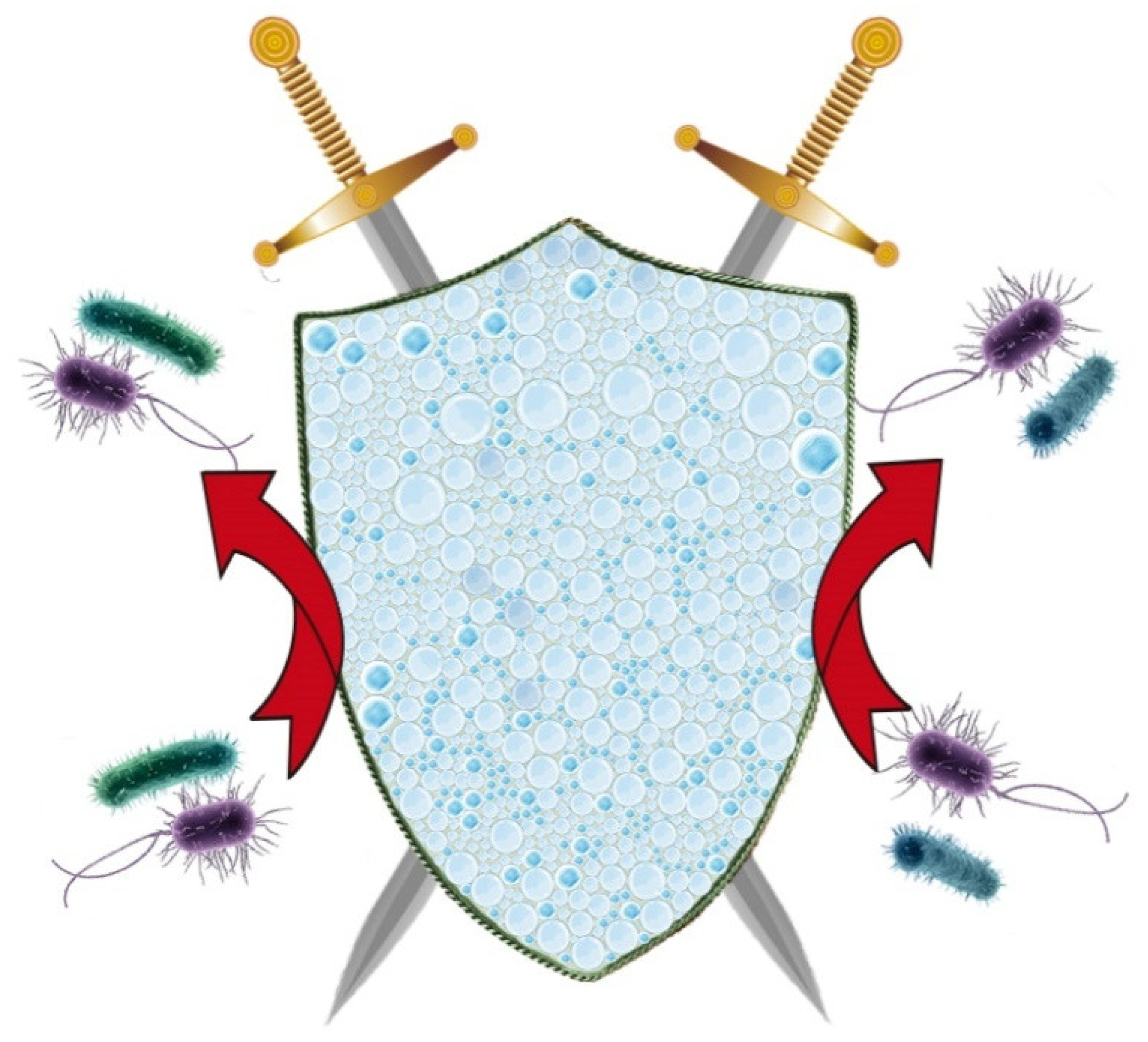
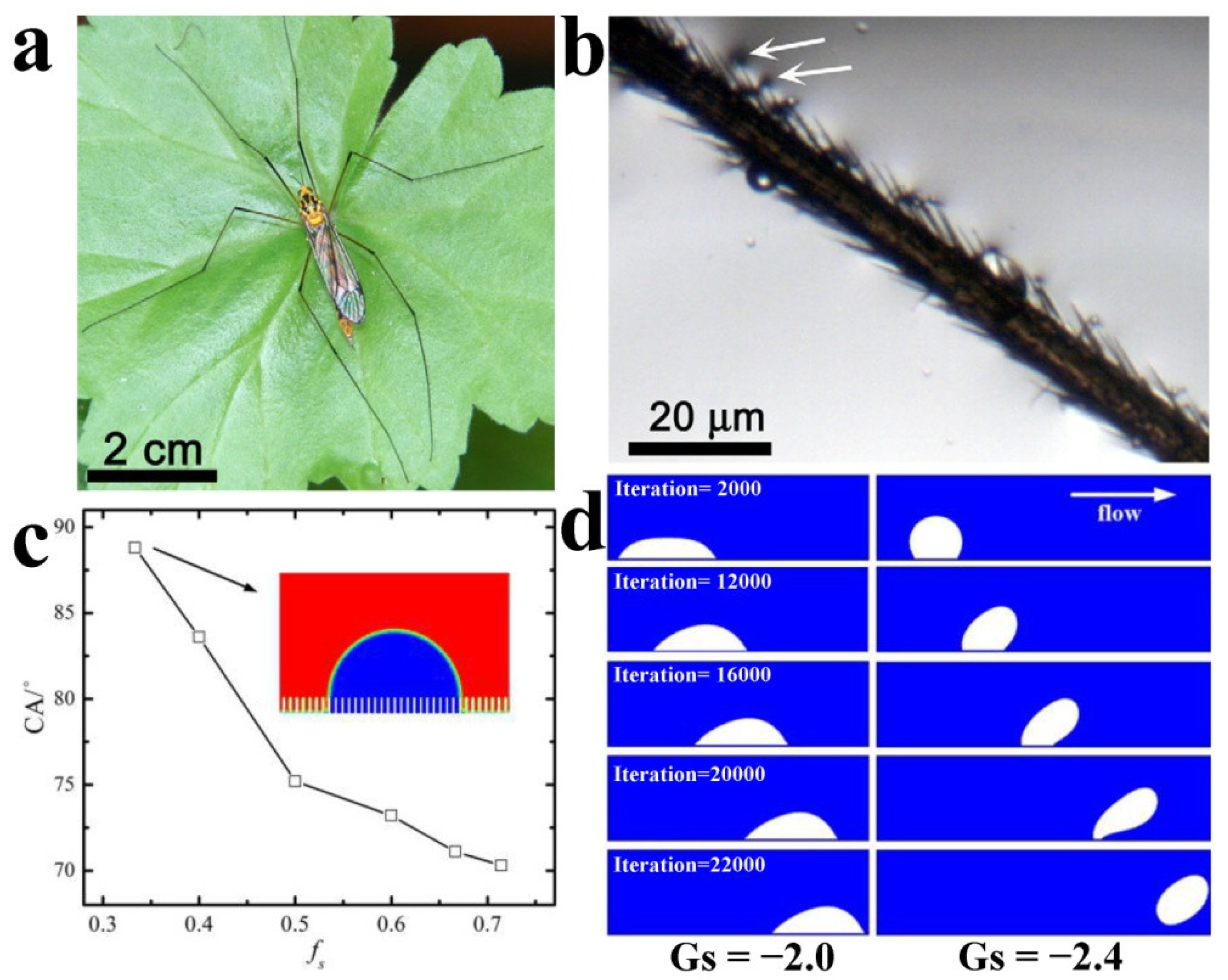
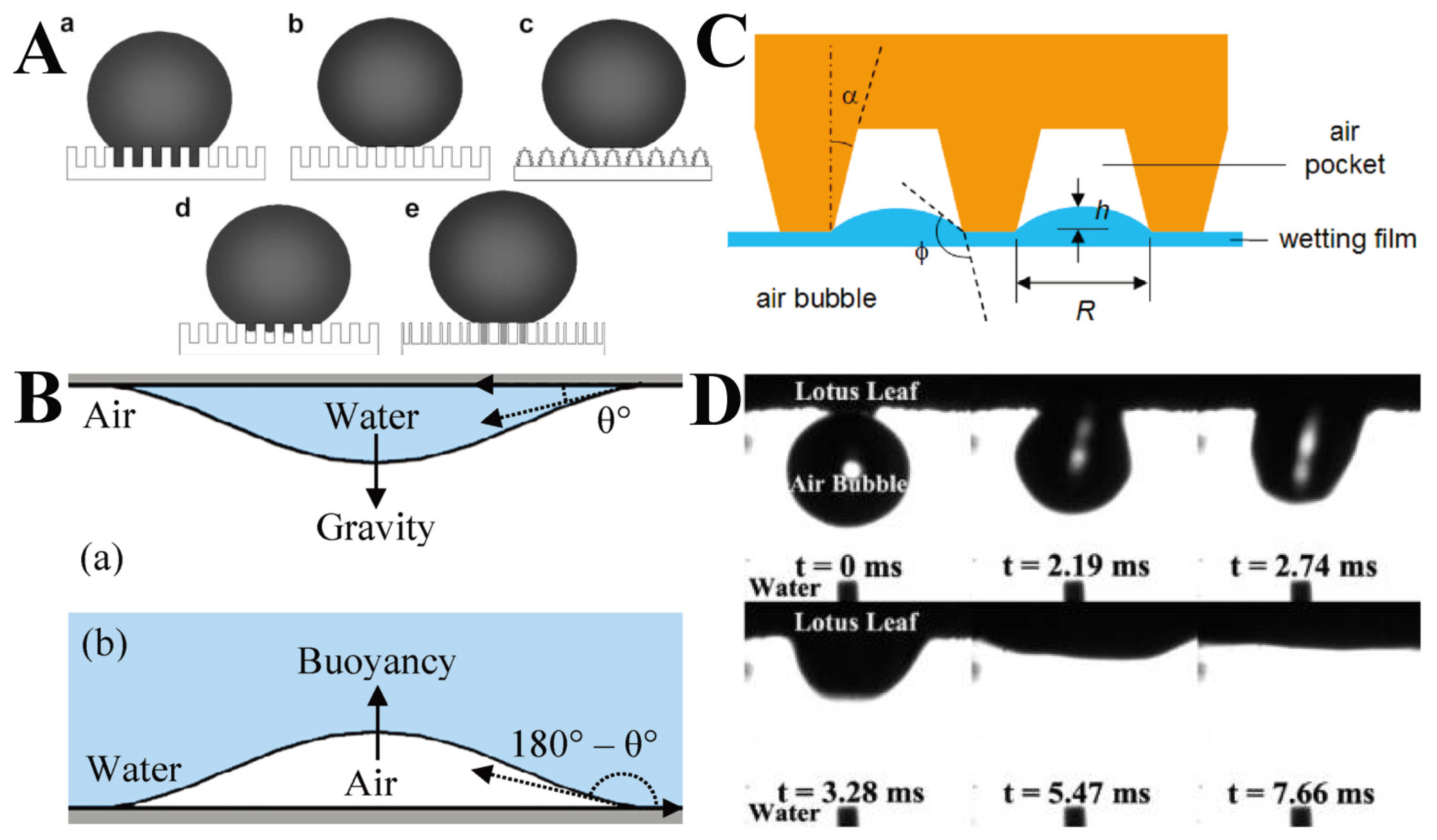
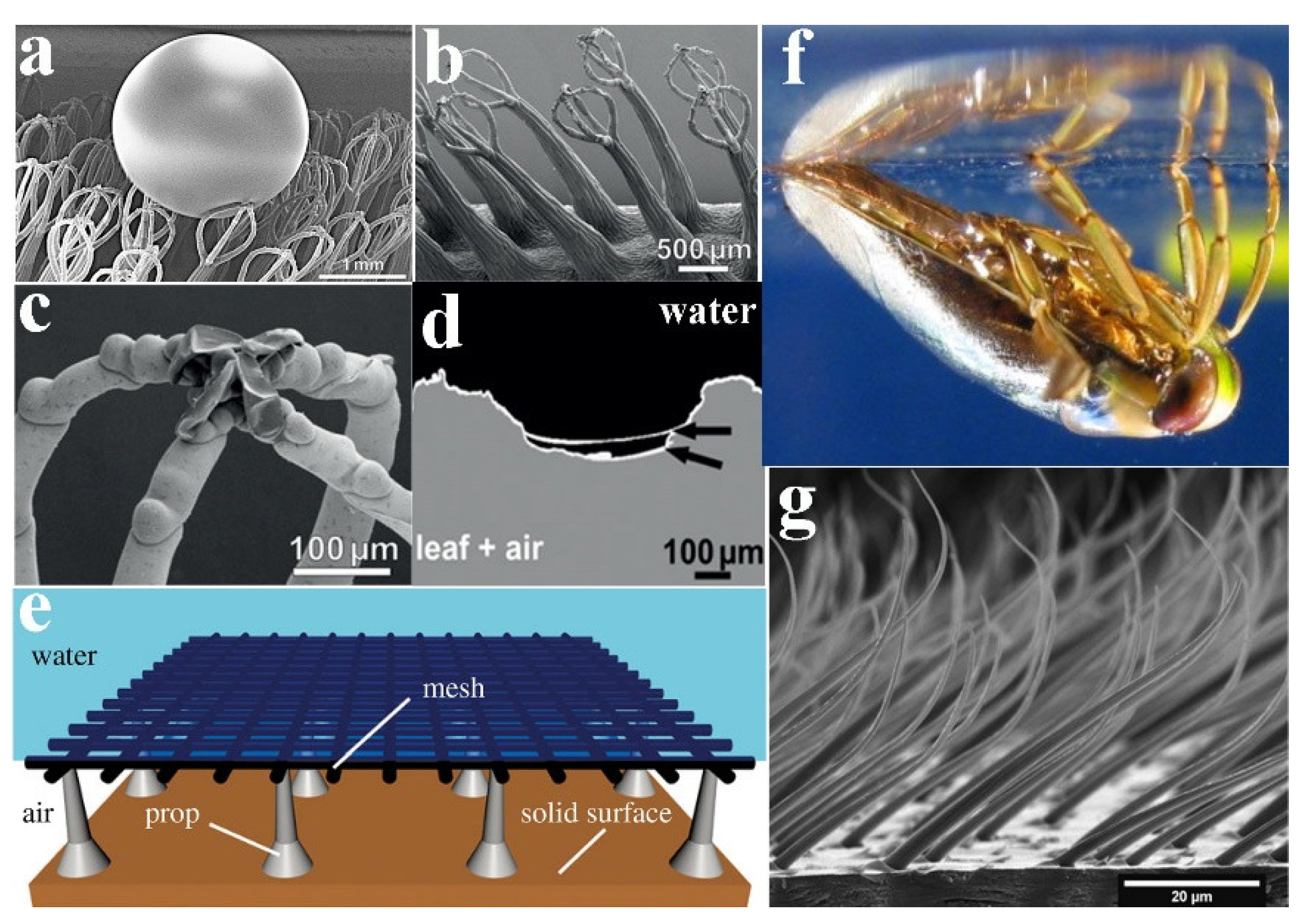
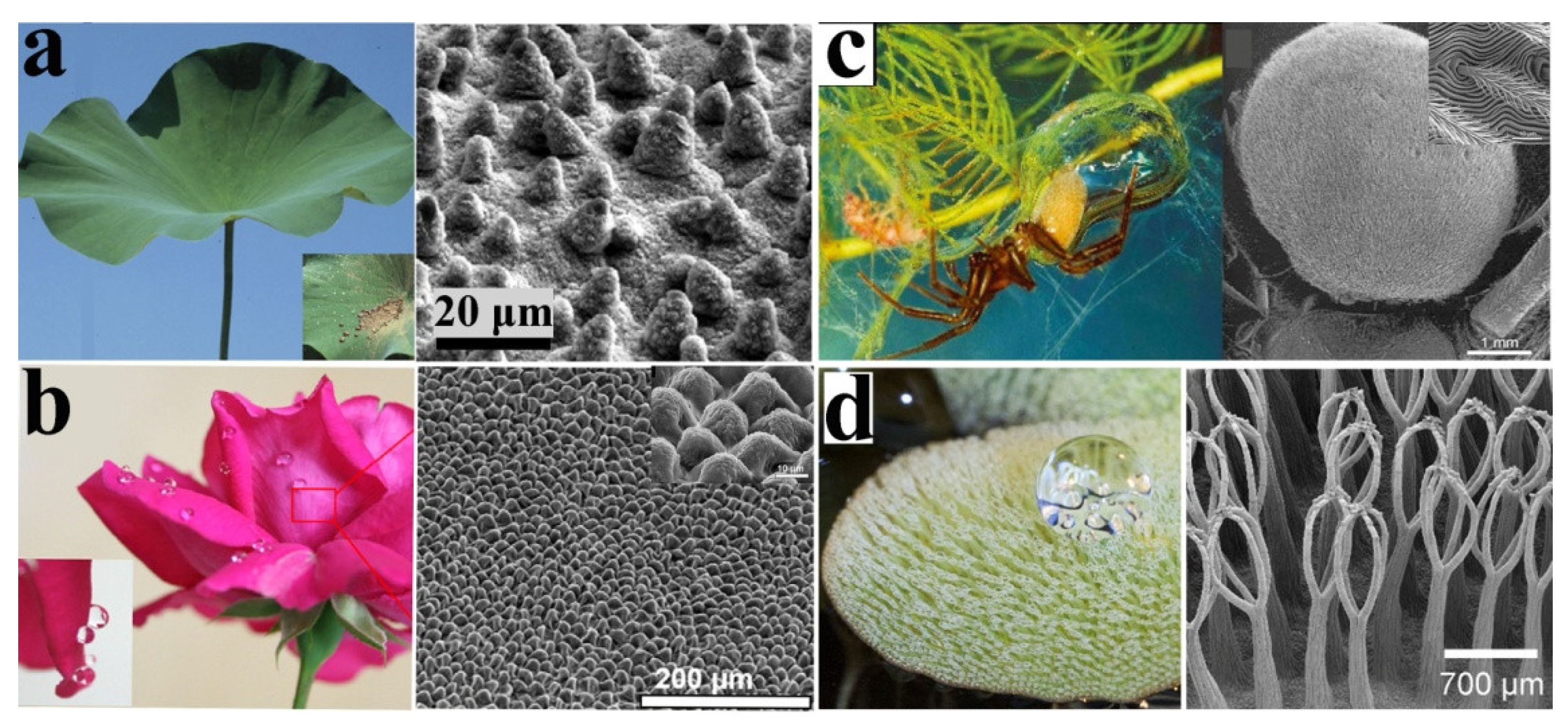
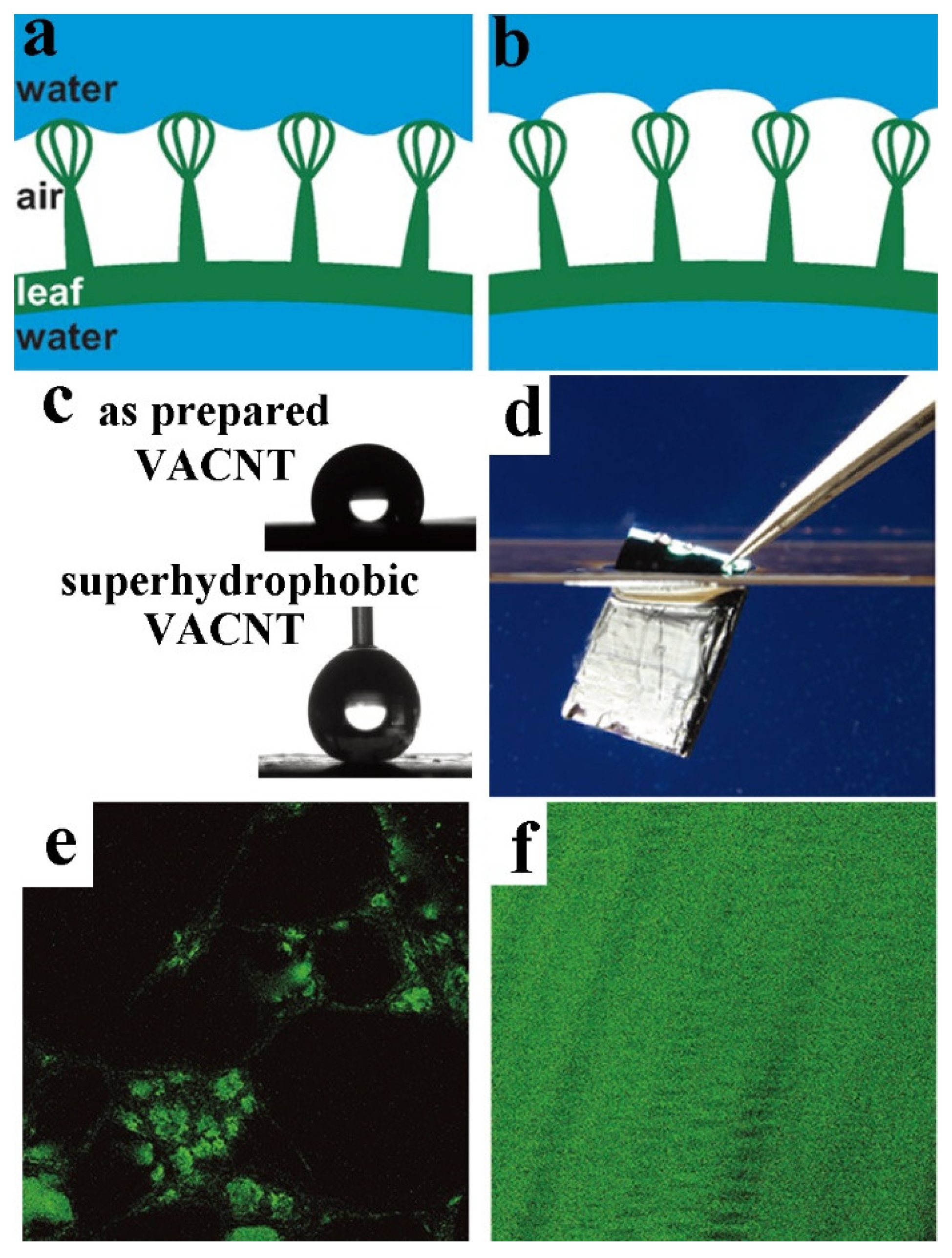
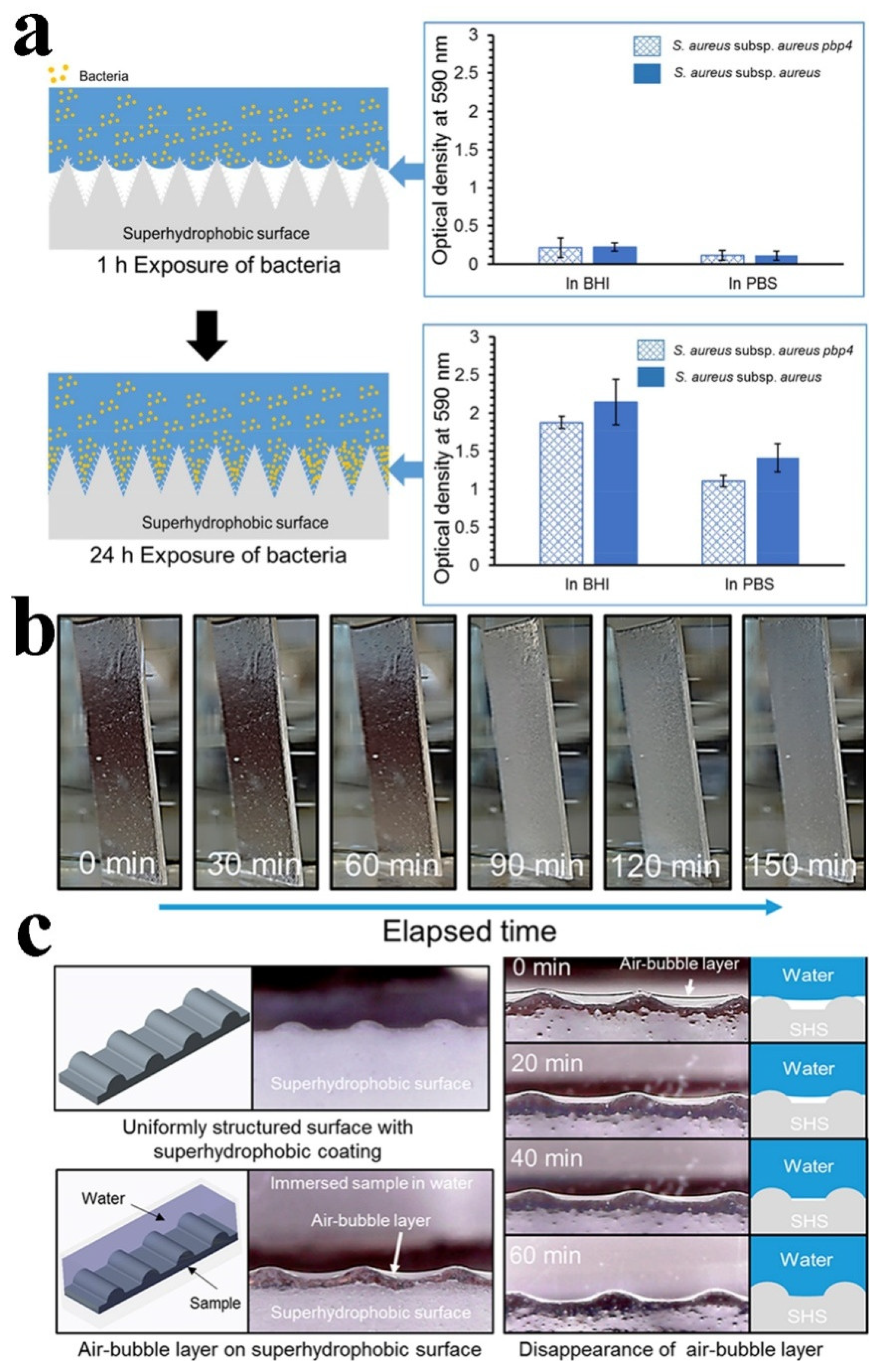
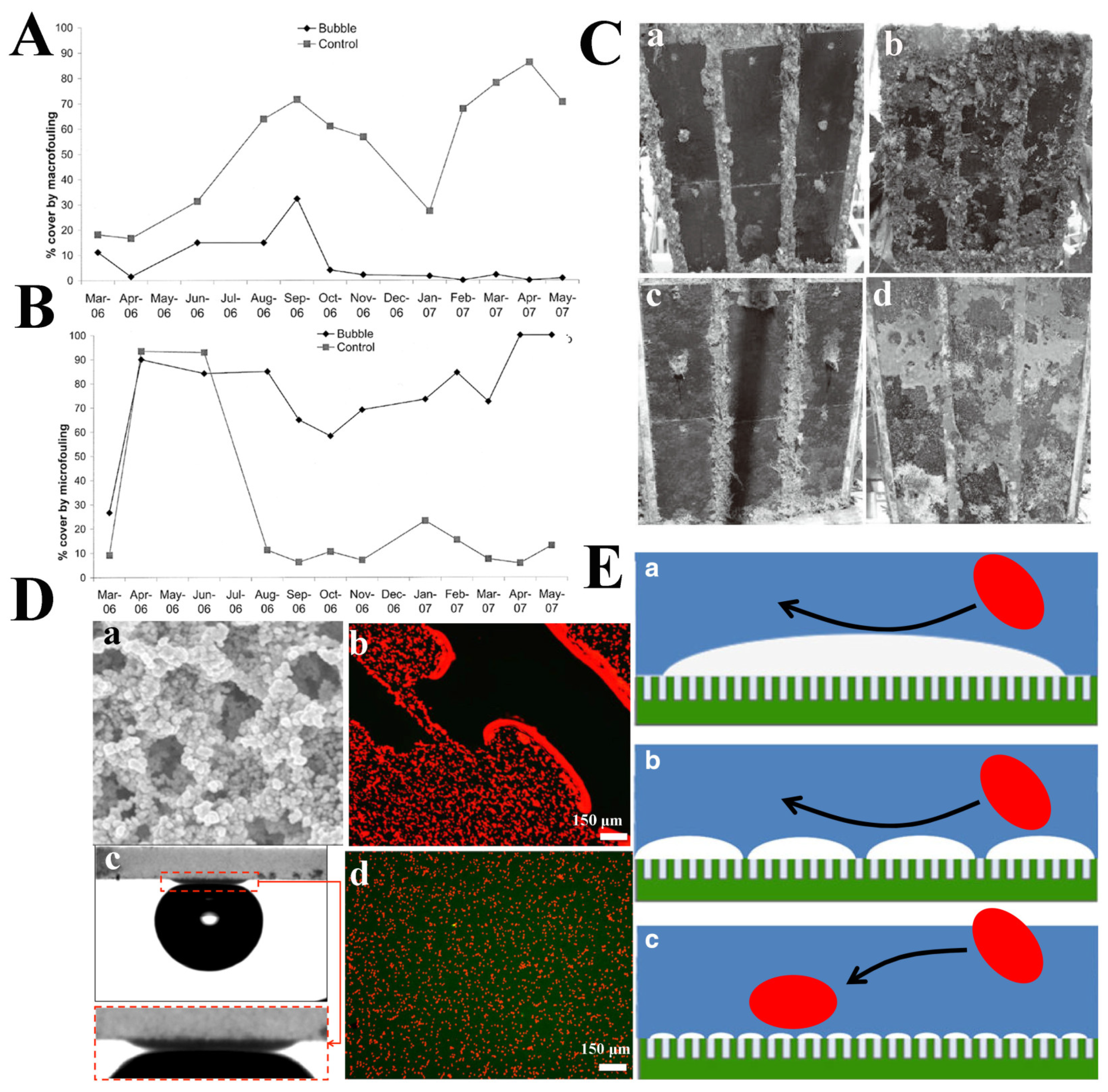
Publisher’s Note: MDPI stays neutral with regard to jurisdictional claims in published maps and institutional affiliations. |
© 2021 by the authors. Licensee MDPI, Basel, Switzerland. This article is an open access article distributed under the terms and conditions of the Creative Commons Attribution (CC BY) license (https://creativecommons.org/licenses/by/4.0/).
Share and Cite
Cai, Y.; Bing, W.; Chen, C.; Chen, Z. Gaseous Plastron on Natural and Biomimetic Surfaces for Resisting Marine Biofouling. Molecules 2021, 26, 2592. https://doi.org/10.3390/molecules26092592
Cai Y, Bing W, Chen C, Chen Z. Gaseous Plastron on Natural and Biomimetic Surfaces for Resisting Marine Biofouling. Molecules. 2021; 26(9):2592. https://doi.org/10.3390/molecules26092592
Chicago/Turabian StyleCai, Yujie, Wei Bing, Chen Chen, and Zhaowei Chen. 2021. "Gaseous Plastron on Natural and Biomimetic Surfaces for Resisting Marine Biofouling" Molecules 26, no. 9: 2592. https://doi.org/10.3390/molecules26092592
APA StyleCai, Y., Bing, W., Chen, C., & Chen, Z. (2021). Gaseous Plastron on Natural and Biomimetic Surfaces for Resisting Marine Biofouling. Molecules, 26(9), 2592. https://doi.org/10.3390/molecules26092592






